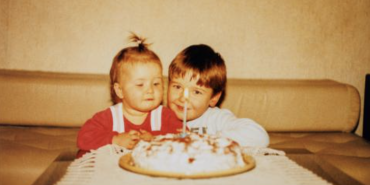This Is My Story, This Is My Song

I am the son of a great storyteller. Like most people, I can't remember much about my early childhood. But I could tell you about it in great detail. Instead of memories, my childhood is constructed predominately by the stories of my father.
I think that's pretty cool.
I have been listening to my dad tell stories from the pulpit all my life. I used to wonder why they made people laugh and then cry all within half an hour, but now I don't wonder anymore. They make me laugh and cry as well.
My father is a hard man to get to know. He is quiet and careful with his words. Yet, what I have found as I walk closely now among the stomping grounds of my father's early ministry is that hundreds of people feel they know my father—and they do. They feel like they have seen the very colors of his soul—and they have. They feel like they can call him a friend and a brother in Christ because they have heard his stories—and they can.
My praise and worship band played the song "Blessed Assurance" at a church service the other day. It is always fun to gauge the reactions we get when we play old hymns. Immediately, some of the older congregants begin to raise their hands and sing louder than before. The young people in the church, most likely brought up on Chris Tomlin and David Crowder, usually say, "Yes, I love Third Day."
The author of this song is a woman whose name was Fanny. Along with "Blessed Assurance," she wrote thousands of hymns that still reside in the hymnals folded neatly into church pews. Fanny Crosby was blinded by a failed procedure when she was a baby, and yet rose above her circumstances to become one of, if not the, most prolific hymn writers of all time. She met many dignitaries, and even played a song at Ulysses Grant's funeral in 1885. On her tombstone are the words "Aunt Fanny" and "Blessed Assurance, Jesus is mine, Oh what a foretaste of glory divine."
She once said these words:
It seemed intended by the blessed providence of God that I should be blind all my life, and I thank Him for the dispensation. If perfect earthly sight were offered me tomorrow I would not accept it. I might not have sung hymns to the praise of God if I had been distracted by the beautiful and interesting things about me.
Now that's a good story.
And knowing it breathes new life into the song. What was once a catchy chord progression mixed with some nice lyrics becomes a tale of perseverance and triumph. A tale of God working in the midst of darkness.
As I mentioned, my father is a minister. My mom is an art teacher and a woman of God. So I was raised on two things: art and God. Not a bad way to grow up, if I say so myself.
I am amazed as I grow older how hard it is to distinguish between the two. Just as I see God everywhere, I see art everywhere. Every film, every painting, every poem, every song, even if ever so slightly, holds a glimmer of truth and beauty. Sometimes it's so bright it's staggering. And woven neatly into the fold of God and art are humans and our stories. Or rather, our story.
The other day I was having lunch with some friends from work at a local art museum. As we were viewing some of the contemporary paintings in the cafe there, my friend Stephanie made an interesting comment. She said that the best of art is art that tells a story. I think that's very true.
Her comment was directed at the strange and undecipherable paintings around us, but I think if the creator of those paintings were there he or she could have told us the purpose behind each stroke of the brush.
Maybe the reason it is so hard to separate art from God is that there was never meant to be a distinction between the two.
And the centerpieces of this grand and ancient gallery—God's Creation—are you and me. If this is so, then we have no choice but to do our duty as the best of art and tell our stories, explain our colors, and exhibit the brush strokes of our Creator.
And in the telling, whether it is to hundreds or to just a few, whether it is with pictures, written words, or spoken words, we illuminate the very purpose behind our lives: to know and love each other and to be truly known and loved.
I have the privilege of creating videos to display biblical ideas to the youth of our denomination. Recently, I was working on a video about image and identity when I came across the character of Jacob. A key moment in his story is when Jacob wrestles all night with an angel of the Lord, then upon declaring his name (a huge step for him) is given a new one: Israel.
Now, I think there are layers of meaning to this moment, but one that struck me when thinking about story is that God is reminding Jacob of his place in what we call the "Big Picture."
The colors of Jacob's life were bold and beautiful. He was the father of a nation, and from his bloodline there arose many kings. Yet, just like you and me, these colors blend perfectly into the storyline of a grand and masterful tale that is still unfolding today. His struggles are ours—His failures and triumphs resonate within us.
His story is our story: the story of God's people.
The art of storytelling is as ancient as time. Whether we relate or sympathize, whether we are listening or telling, stories connect us together as a body—a community. Stories allow us to step back and take a long look at the blooming masterpieces forming all around us.
I am the child of a great storyteller. I can't remember much about the history of my people. My history is not constructed by memories, but by the stories of my Father.
My name is Israel.
Jason Sivewright is a worship leader at Olathe, Kansas, College Church of the Nazarene.
Holiness Today, Nov/Dec 2009
Please note: This article was originally published in 2009. All facts, figures, and titles were accurate to the best of our knowledge at that time but may have since changed.




